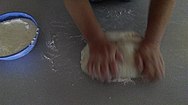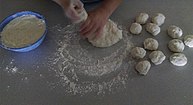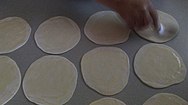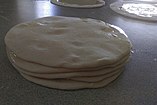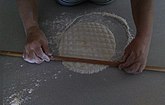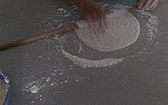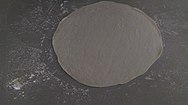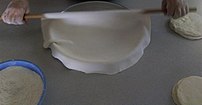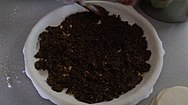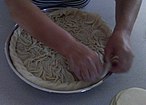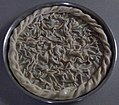Lakror

 Lakror with spinach filling | |
| Type | pastry (pie) |
|---|---|
| Place of origin | |
| Region or state | Korçë region, Pogradec region, Devoll region (Albania) Bitola and Lake Prespa regions (North Macedonia) |
| Main ingredients | flour, oil, lamb, beef, ricotta, feta, cabbage, nettle, spinach, orache, squash, leek, sorrel, tomato, pepper, eggs, milk |
Lakror (Gheg Albanian: Laknor, Arbëreshë Albanian: Lakruar) is a traditional and common regional Albanian pie dish of Albania made with different fillings consisting of various vegetables or meat.[1][2][3]
Lakror is associated mainly with Korçë and its surrounding areas and considered a specialty by local Albanians.[4][5] The pie is made in some other parts of southern Albania.[6] Lakror is also consumed by Albanian communities in south-western North Macedonia,[7] and by Albanians abroad[8] or in the diaspora in places like the US[1][9][10] and Australia.[11] The pie is sometimes called a type of byrek pastry[12][11][13] or compared to an American pie.[1]
Etymology
[edit]The term lakror is derived from the Albanian word lakër (cabbage, leafy vegetable).[14][1] The vegetable was probably the original foundation of the pastry dish.[1]
Preparation
[edit]Traditionally Albanian women have been involved in preparing a lakror.[7]
The preparation of lakror is a hands on process that involves working and rolling the filo dough into thin layers, later opening the pastry and placing it in a tin,[1][2][7] or pan. The gjellë (filling) is prepared separately by boiling minced vegetables.[1] A variety of fillings can be made from different vegetables such as cabbage, nettle, spinach, orache, squash, or those with a strong flavour like onions and leeks.[1][3][12] Other fillings are made from meat such as beef, lamb or involve combining ingredients like tomato and onion, tomato and pepper, spinach with cheese or with eggs, milk and (olive) oil.[13][11][3] Sizable portions of gjellë is added to the pastry.[1]
- Mixing flour, water and a pinch of salt to make dough
- Working the dough by hand
- Making kulaç (dough balls)
- Rolling out kulaç with a okllai (rolling pin) into small petë (flat dough layer)
- Placing oil on each small petë
- Assembling 5 petë into stack (can go to 10). This process creates pastry flakiness when baked.
- Petë stack pressed and bound with a criss-cross pattern
- Petë stack rolled out to make one large petë
- Petë becoming larger during rolling process
- Petë placed atop an oiled tepsi (pan) using rolling pin
- Petë adjusted within pan
- Gjellë (filling) added atop bottom petë
- Second petë, slightly larger, made for top
- Second petë placed atop pan
- Top petë adjusted within pan
- Oil added on top to create crispiness when baked
- Excess pastry of both petë is bound into thembra (knotted crust)
- Lakror ready for baking
Apart from traditional lakror, there are other variations such as brushtul lakror made from eggs, butter and a filling with feta and cottage cheese.[13]
Among Orthodox Albanians, Lakror is also made for commemorating St. Basil's day.[15] In some Arbëreshë (Italo-Albanian) communities of southern Italy, the dish is called lakruar and prepared with a filling of cheese, chicken, mixed pork and sheep meat and cinnamon.[16]

Organised by the Korçë municipality, an annual Lakror Festival (Albanian: Festa e Lakrorit) is held in Korçë or sometimes in a village of the wider area.[5][17] As a celebration of summer and Albanian cuisine, the festival is attended by locals and tourists.[5] Many lakrors are prepared and then baked in a Saç, a cooking utensil that is covered atop with hot embers.[5]
See also
[edit]External links
[edit]Traditional preparation styles
[edit]- Lakror with pickled cabbage filling (video) [1]
- Lakror with leek filling (video) [2]
- Lakror with onion and tomato filling, cooked in a saç (video) [3]
- Lakror as made by Albanians from south-western North Macedonia (video) [4]
Other preparation styles
[edit]- Lakror with onion and tomato filling (video) [5], [6]
- Lakror made from cornflour with spinach filling (video) [7]
- Lakror with leeks and minimal flour (video) [8]
- Lakror with chicken (and rice) as traditionally made by Cham Albanians (video) [9], [10]
Other
[edit]- News footage from the Lakror festival (video) [11], [12], [13]
- Onion and mixed meat Lakror recipe [14]
References
[edit]- ^ a b c d e f g h i Federal Writers' Project of the Works Progress Administration of Massachusetts (1975). The Albanian Struggle in the Old World and New. AMS Press. p. 157. ISBN 9780404579258. "Lakror, one of the commonest Albanian dishes, resembles an American pie. To make it, the cook rolls dough or paste to a thin layer, places it in a well - greased tin, and generously anoints it with gjelle, or filling. Gjelle usually consists of some succulent vegetables, boiled and then finely minced. Since the word lakror is derived from the Albanian term for cabbage, that vegetable was perhaps the basis of the original concoction; but other vegetables are frequently used. Those of pungent and penetrating flavor, such as leeks, onions, squash and spinach are prime favorites."
- ^ a b Erol, Ali E.; Gjata, Joris (2013). ""Doğmamış Çocuğa Don Biçmek": Visions of a Multicultural Family". In González, Alberto; Harris, Tina M. (eds.). Mediating cultures: Parenting in intercultural contexts. Rowman & Littlefield. p. 127. ISBN 9780739179543.
- ^ a b c Levinson, David; Ember, Melvin (1997). American Immigrant Cultures: Builders of a Nation, Volume 1. Simon & Schuster. p. 30. ISBN 9780028972084. "These traditional foods include barbecued roast lamb; spinach; leek or squash - filled pies (lakror)"
- ^ "Lakrori, traditë e herëshme në Korçë". Korça News. 16 September 2018. Retrieved 16 January 2021.
- ^ a b c d "Festa e lakrorit në Korçë". Ora News. 4 September 2019. Retrieved 16 January 2021.
- ^ Hasko, Blegina (2013). "Vëzhgim mbi ushqimin tradicional të Bregut të Detit". Kultura Popullore (1–2): 6.
- ^ a b c Sugarman, Jane (1997). Engendering song: Singing and subjectivity at Prespa Albanian weddings. University of Chicago Press. p. 368. ISBN 9780226779720.
- ^ Vullnetari, Julie (2012). Albania on the Move: Links Between Internal and International Migration. Amsterdam University Press. p. 172. ISBN 9789089643551.
- ^ Henderson, George; Olasiji, Thompson Dele (1995). Migrants, Immigrants, and Slaves: Racial and Ethnic Groups in America. University Press of America. p. 138. ISBN 9780819197382.
- ^ Kadija, Refik (1994). American Studies in Albania in the Past and the Future (PDF). Free University of Berlin. p. 12.
- ^ a b c Ahmeti, Sharon (2017). Albanian Muslims in Secular, Multicultural Australia (Ph.D.). University of Aberdeen. p. 197. Retrieved 1 December 2020.
- ^ a b Thomaj, Jan (2002). Fjalor i shqipes së sotme: me rreth 34.000 fjalë. Botimet Toena. p. 648. ISBN 9789992716076.
- ^ a b c Reference Library of European America (Volume III) Countries Albania to Italy. Gale Research. 1998. p. 18. ISBN 978-0787629663. "Albanian pies, lakror-byrek, are prepared with a variety of gjelle ("filling"). Fillings may be lamb, beef, cabbage, leeks, onions, squash, spinach, combined with milk, eggs, and olive oil. A lakror known as brushtul lakror is made with a cottage and feta cheese filling, butter and eggs. Domate me qepe is a lakror made with an onion and tomato filling."
- ^ Elezi, Mehmet (2006). Fjalor i gjuhës shqipe. Gjergj Fishta. p. 795. ISBN 9789994387465.
- ^ Vitz, Evelyn Birge (1991). A Continual Feast: A Cookbook to Celebrate the Joys of Family and Faith Throughout the Christian Year. Ignatius Press. pp. 161, 163. ISBN 9780898703849.
- ^ Bellettieri, Carmensita (1 March 2022). "Dalla Basilicata, il tortino agrodolce di Carnevale" (in Italian). Retrieved 1 March 2022.
- ^ Gegollari, Nertila Astrit (27 August 2010). A Tourism Development Plan for Korça County, Albania (PDF) (Masters). Utica College. p. 95. Retrieved 16 January 2021.

